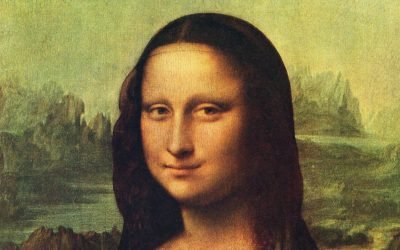The 19th century marked a turning point in art history, as traditional notions of ideal art as the most realistic and beautiful began to give way to new subjects and philosophical ideas. Influenced by both pro- and anti-Enlightenment thinkers, artists of this era, such as J.M.W. Turner, sought to portray movement and the rapidly changing environment of the time rather than focusing solely on achieving perfect realism. However, these artists still depicted real things that exist in our world.
As the century drew to a close, a new wave of artists started to revolt against the idea that art needed to represent reality, pushing the boundaries of intelligibility and human cognition. But where does the line between art and “non-art” lie? At what point does a creation cease to be justifiably called art? In this article, I will explore this elusive borderline and attempt to determine the point of no return in the evolution of artistic expression.
Mimesis: A Brief History

(Megalith Grave in Winter, Johan Christian Dahl, 1825)
In our popular culture, the visual arts are filled with what is commonly known as “modern art.” The key distinction between modern art and classical art lies in their deviation from the concept of “mimesis.” Mimesis is an ancient Greek term that means “to imitate.” It was used to describe what should be the primary function of art: to imitate and represent reality. According to both Aristotle and Plato, the basic purpose of art is to mimic reality. The more effectively art imitates reality, the greater its ability to resonate with viewers, convey abstract ideas, and evoke emotional responses.
Excellent and beautiful art should be realistic. An artist whose paintings are an inaccurate imitation of reality is a bad artist. This notion was evident across various art movements up until the end of the 19th century.
From Romantic Realism and Impressionism to Naturalism and the Barbizon School, most art movements shared the common goal of depicting subjects that exist in reality, regardless of their specific subjects or stylistic choices.
They all conformed to the fundamental principle that the most basic skill that an artist needs to develop is his ability to realistically represent reality (the same principle applies to all the different types of art, such as painting, sculpture, literature, poetry, etc.). The most celebrated artists in those times were those who managed to reach the highest level of mimesis in their work.
The Revolt Against Mimesis

(The Card Players, Paul Cézanne, 1895)
During the end of the 19th century and the beginning of the 20th century, influential artists such as Paul Cézanne (1839–1906), Henri Matisse (1869–1954), and Pablo Picasso (1881–1973), among many others, advocated for the idea that art does not have to represent reality. It started with the small details, with Cézanne painting the heads of the card players disproportionately. We shall soon see that mimesis will entirely cease to exist as a component of art.

(Portrait of Madame Matisse, Henri Matisse, 1905)
Later on, in his “fauvistic colors,” Matisse disconnected any ties between his usage of color and reality. Sure, colors were not always true to what was in front of the subject artists were painting, but what has always persisted until the days of Matisse was the attempt to remain as faithful as possible to what colors the artist saw in reality. Matisse used color not to achieve an accurate re-creation of reality but rather to create a certain stark contrast, which he was fond of.
Note that this is still within the borders of art because it is intelligible; We can understand what Matisse was trying to portray; This painting is still influenced by the idea of mimesis.

(Ma Jolie, Pablo Picasso, 1912)
This early 20th-century anti-mimesis development has reached its climax in “Cubism.” This painting by Picasso represents an entirely broken-up version of reality. An almost full 180-degree turn from what would be traditionally considered a fine work of art.
Not only is this painting the opposite of what would be traditionally considered good art, but this painting also cannot be regarded as art. At least not art in its full sense. Such objects can have various esthetic qualities and could be used as decoration in hotel hallways and hospitals, but this is not art in the full sense.
Viewing it as a work of art is wrong and a disgrace to all other works of art. When art depicts a mockery of reality, it leaves itself outside the art equation. When you don’t represent reality in your art, it can no longer serve as a medium for communicating ideas and values. It becomes a whimsical, subjective creation. Therefore, it deserves a different treatment. It needs a different concept.
If an art critic treats a work such as Picasso’s “Ma Jolie” from the same perspective that he will treat works by Raphael or even by Renior, he is acting in profound injustice.
Where is the Borderline?

(Two Sisters, Pierre-Auguste Renoir, 1881)
To determine if an artwork adheres to the principles of mimesis (pro-reality, representational), one should ask, “Does this work attempt to portray reality?” Examining the works of Renoir or Monet, it becomes evident that there is a conscious and deliberate effort to capture reality, even if through a unique lens. However, with Cézanne’s art, this intention to represent reality starts to fade, marking a shift away from the tradition of mimesis. When we observe his works, we can spot intentionally disproportionate dimensions. Instead of an active effort to represent reality, we see an active effort to distort reality.
Still, Cézanne’s subjects are human beings engaged in a recognizable activity. There’s something intelligible going on there—the same thing is true with Matisse. We can see that this is a portrait. But when we reach Picasso, we can’t see anything intelligible. We can maybe spot some disconnected objects, but without a manual, this is entirely unintelligible. Art needs to reduce the abstract to the concrete level. Here we have the opposite case. This is where the line is drawn—when there’s no longer any indication of something real and intelligible being depicted.




